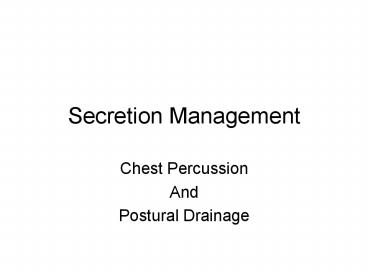Secretion Management - PowerPoint PPT Presentation
1 / 20
Title:
Secretion Management
Description:
Pain. Chest Percussion. Contraindications. Hemoptysis after lung resection ... Chest pain. Resected tumors of the thorax or neck. Chest Percussion. Hazards ... – PowerPoint PPT presentation
Number of Views:415
Avg rating:3.0/5.0
Title: Secretion Management
1
Secretion Management
- Chest Percussion
- And
- Postural Drainage
2
Chest Percussion
- Defn chest percussion refers to a series of
manipulative techniques designed to assist with
bronchial hygiene the mobilization of secretions
from the tracheobronchial tree.
3
Chest Percussion
- Integrated modalities
- Postural drainage
- Vibration
- Cough assistance
- Breathing instruction
4
Chest Percussion
- Goals
- Prophylaxis to prevent retained secretions
- Improve mobilization of secretions
- Improve distribution of ventilation
- Promote more efficient breathing patterns
- Promote effective cough
5
Chest Percussion
- Indications
- Acute conditions
- Acute pulmonary disease with copious secretions
- Acute lobar atelectasis
- Acute conditions of questionable benefits
- Exacerbation of COPD w/scant secretions
- Pneumonia w/o sputum production, e.g., viral
- Status asthmaticus
- Status Post (S/P) coronary artery bypass graft
surgery (CABG)
6
Chest Percussion
- Indications
- Chronic conditions
- Chronic production of large amounts (30 ml/day)
of secretions - Cystic fibrosis
- Bronchiectasis
- Chronic bronchitis
- Lung abcess
- Collection of pus within the lungs as opposed to
empyema, which is pus in the pleural space.
Chest tube drainage is required for empyema.
7
Chest Percussion
- Hazards/Complications
- Hypoxemia when affected side is dependent
- Cardiovascular instability
- Internal hemorrhage post Sx
- Hemoptysis after lung surgery
- Fractured ribs, e.g., osteoporosis
- Increased ICP
- Dyspnea
- Pain
8
Chest Percussion
- Contraindications
- Hemoptysis after lung resection
- Uncontrolled hypertension
- ICP 20 mm Hg
- S/P neurosurgery, aneurysm, eye surgery
- Suspected TB
- Osteomyelitis
- Osteoporosis
- Chest pain
- Resected tumors of the thorax or neck
9
Chest Percussion
- Hazards/Complications
- Vomiting
- Wheezing
- Bronchospasm
- Acute hypotension
- Aggravate lung contusion, coagulopathies
10
Percussion Techniques
- Hand
- Cupped hand will trap air to cause a popping
sound on contact - Use the cover sheet or patient gown over skin
- Vibes
- Arms extended tensed when pushing firmly against
pts chest during exhalation - Shaking
- Shaking hands on pts chest during exhalation
- Percussor, Swedish massager, etc.
- Good for pts who do not tolerate hand percussion
11
Postural Drainage
- Defn method of removing pooled secretions in
the tracheobronchial tree by positioning the
patient to allow gravity to assist in the
movement of secretions.
12
Postural Drainage
- Goals
- Facilitate mobilization of secretions in the
bronchial tree - Improve distribution of ventilation
- Improve gas exchange by improving V/Q mismatch
- Indications
- Same as for chest percussion
- OK for those who do not tolerate percussion
13
Postural Drainage
- Contraindications
- Unstable hemodynamics
- Untreated hypertension
- Internal and external head injuries
- Gross obesity
- Empyema
- Severe dyspnea at rest in high Fowlers or supine
- Recent meals or tube feedings (allow 30 mins
after) - Spinal cord injuries
14
Postural Drainage
- Bed position
- Flat
- Tredenlenburg 15-18 foot of bed ?
- Reverse Trendelenburg 15-18 head of bed ?
- High Fowlers 30-45º head upright
- Semi or mid Fowlers 15-30 º head upright
15
Postural Drainage
- Body position
- Dependent position down side
- Independent position upside
- Prone
- Supine
- Lateral
- 3/4 prone
- 3/4 supine
16
Postural Drainage
- Moving patients into position
- Explain to patient what you will be doing
- If patient alert, let him or her know to let you
know if he or she experiences SOB, headache,
pain, etc. - If patient is ambulatory, ask him or her to move
into position assist if necessary - Ask for help if patient is unconscious and large
- Move patient into position prior to placing bed
into Trendelenburg
17
Postural Drainage
- Positioning patient for safety and comfort
- Patient should always be turned and face YOU
- Monitor patients facial expressions for pain,
discomfort, and signs of breathing distress - Adjust patients arms and legs using pillows b/t
the knees avoid bone to bone contact - Support the head with a pillow
- Tuck pillow behind back and abdomen for stability
- Watch those IV lines and urinary catheter
- Urinary catheter should be on your side
- Make sure side rails are up opposite you
18
Lung Segments
- Right lung (10 segments)
- RUL
- Apical segment of the RUL
- Anterior segment of the RUL
- Posterior segment of the RUL
- RML
- Middle (medial) segment of the RML
- Lateral segment of the RML
19
Lung Segments
- Right lung
- RLL
- Anterior basal or segment of the RLL
- Lateral basal or segment of the RLL
- Medial basal (cardiac lobe) or segment of the RLL
- Posterior basal or segment of the RLL
- Superior basal or segment of the RLL
20
Lung Segments
- Left lung (8 segments)
- LUL
- Apical-posterior segment of the LUL
- Anterior segment of the LUL
- LML
- Superior lingula
- Inferior lingula
- LLL
- Anterior-medial basal or segment of the LLL
- Posterior basal or segment of the LLL
- Lateral basal or segment of the LLL
- Superior basal or segment of the LLL































